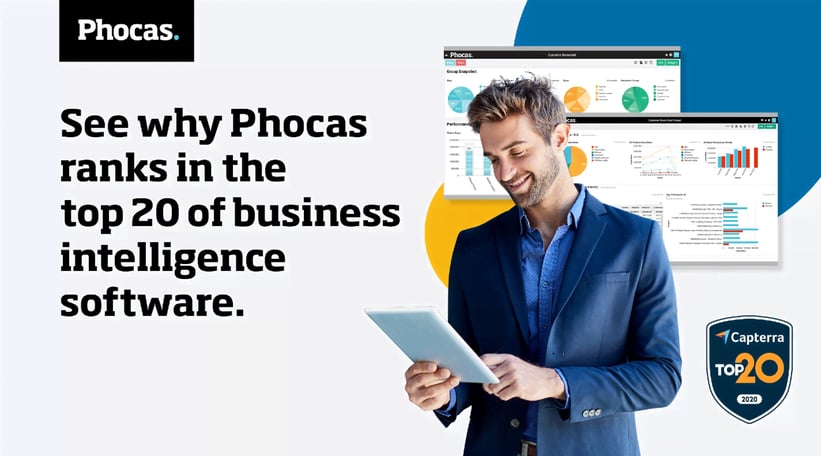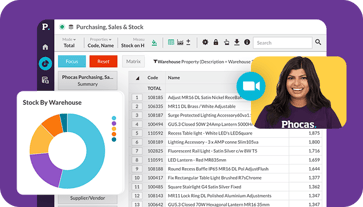How to choose the best business intelligence software
Selecting the right business intelligence (BI) software is more than just picking a tool that displays data in colorful graphs and dashboards. It’s about empowering your people with insights to make data-driven decisions that benefit customers and your financial performance. Whether you're upgrading your reporting tools or adopting BI software for the first time, a trusted approach ensures your investment delivers a strong return. Here’s a comprehensive guide to choosing the best BI solution for your business based on customer feedback, experience and best practice.
1. Define your business needs and objectives
Before diving into features and functionality, take a step back and determine what you’re trying to achieve.
Clarify your key business goals and the decisions you expect the business intelligence platform to support. Are you trying to streamline operations away from Excel spreadsheets, boost sales, or track performance? Maybe all of these. Identify the primary KPIs and metrics that matter most to your stakeholders. The best BI tools make these metrics accessible and actionable.
Map out department-specific needs and use cases, such as finance, might need granular variance analysis, while sales might focus on sales performance and forecasting. It is also a good idea to list all your current data challenges. Whether it’s disconnected workflows, delays in reporting or lack of visibility, understanding your pain points will help you find a Business analytics tool designed to solve them.
2. Evaluate core functionalities and features
Once your goals are clear, start evaluating BI tools based on the capabilities that matter most to your organization. These four capabilities in an analytics platform rank highly among existing customers.
Data integration and connectivity
When evaluating BI tools, consider the data integration and connectivity capabilities via APIs. Ensure the software can connect to your existing systems like ERPs, CRMs and cloud apps and support flexible data connectors to bring together data from different sources. Some integrations take weeks others can take years!
Data quality and governance
Assess the data quality and data management processes. As data preparation is the foundation for all data discovery, you need a BI tool that prioritizes this in its ecosystem. Find out about the vendor’s data warehouses, ETL processes, data security and its ability to manage large datasets.
Data governance features are also important and whether the platform supports compliance with policies such as GDPR. Verify that the platform offers cloud-based security features such as encryption and role-based access.
Data visualizations and reporting
Look for data visualization capabilities and reporting functionalities, including interactive dashboards, customizable reports, and the ability to drill into data, ensuring there is self-service functionality for non-technical users to explore data independently.
Advanced data analysis
If your business requires more than descriptive analytics, ensure the BI tool includes advanced analytics features like predictive data modeling, scenario planning and machine learning integration.
Independent reviews like the BARC BI Survey help to compare BI tools on these metrics and more, based on real user feedback
3. Focus on usability and user adoption
Even the most powerful business analytics platform can't deliver if your people don’t use it.
An intuitive user-friendly design and self-serve functionality is crucial for ease of use. All users need to be able to explore and create their own reports with drag and drop without needing support or knowledge of SQL. The business intelligence tool should allow reporting or dashboard sharing across departments, as well as having role-based permissions to ensure people only see what they are supposed to see. If your team needs insights while visiting customers or at events, ensure the application performs well across devices.
4. Assess technical capabilities and scalability
As your business grows, your BI tool should grow with it.
When choosing a BI tool, make sure it can handle large data volumes with speed and support near real-time reporting. Scalability is also important, so the tool can accommodate a growing number of business users, data sources and more complex reporting needs like multi-entity or custom metrics.
5. Investigate the support offered by the vendor
A great product is only part of the equation. You also need vendor reliability and support to get you started and to ensure the software continues to provide actionable insights and help you run your business more efficiently.
When assessing vendor reliability and support, consider their reputation and experience by researching vendor history, customer reviews and case studies, especially those relevant to your industry.
Ask what level of customer support is offered, including expected response times and whether you are assigned a knowledgeable customer success person. It is worthwhile to review the vendor's product roadmap to ensure they regularly update their product, introduce new features, and stay ahead of technology trends like natural language queries and AI.
6. Analyze cost and ROI
Business intelligence is a big investment so make sure it pays off.
Pricing transparency is essential to understand their pricing model and whether it is subscription-based, a one-time license, or usage-based. When considering the total cost of ownership (TCO) for business intelligence (BI) software, it is essential to look beyond just the initial licensing fees. TCO encompasses all costs associated with the acquisition, implementation, operation and maintenance of the software over its entire lifecycle.
Add-ons and extensions refer to additional costs for optional modules beyond the analytics tools, plugins or features needed to meet specific business requirements. Operational costs are associated with the daily operation of the software, such as data storage and the time your IT team spend managing the system. Understanding and evaluating the TCO is important for making informed decisions about software investments. It helps to ensure that you are not only considering the immediate expenses but also the long-term financial implications of the software within your organization.
On the flip side, consider the benefits of the BI investment by calculating time saved, increased efficiency and enhanced sales or customer retention. Set realistic milestones to measure progress and evaluate how the software contributes to achieving your organizational goals. By doing so, you can ensure that the business intelligence tool not only addresses immediate needs but also drives long-term value and success for your business.
Score and rank your options
To keep your decision objective, create a simple weighted scoring system based on the checklist above. Score each shortlisted tool on criteria such as usability, integration, ad hoc reporting capability and support. This ensures that the tool you choose aligns with both your current priorities and long-term strategic goals.
How to use the weighted scoring system
-
Assign a weight (e.g 1 to 5) to each criteria based on its importance to your business goals. For example, "Ease of turning ERP data into insights" and "Reducing reliance on IT for reporting" might receive a higher weight than "Advanced data analytics capabilities" if those are your immediate priorities.
-
For each BI tool, assign a score ( 1 to 5) for how well it meets each criteria based on your research, demos and trial usage. Be objective and involve your team in the scoring process.
-
To calculate the weighted scores multiply the weight of each criteria by the score you assigned to each vendor for that criteria.
-
Calculate total weighted score by summing up the weighted scores for each vendor to get a total score.
-
Compare and decide which vendor with the highest total weighted score, based on your defined priorities, is likely the best fit for your business needs.
Selecting top BI software means choosing a partner that will grow with your business and make data insights available to all. Follow these 6 guidelines to pick a BI tool that meets your goals and enhances decision-making.
Use AI to test this methodology out
One great use of generative AI in it’s current state is to prompt it to do this research on your behalf, giving it as much detail about your business, your ERP, your challenges and your aims.
For the example, when prompted to act like a mid-market manufacturer using an Infor Syteline ERP researching BI tools to transform ERP data into insights, enhancing visibility across all sites and offer self-serve reporting, we got the following result: a list of the top four top solutions that best meet these criteria: Phocas Analytics, Microsoft Power BI, Tableau and Qlik Sense. Give it a try for yourself, it could just speed up your decision making process.


Empowering businesses with intuitive data analytics, driving informed decisions for growth and profitability. We make people feel good about data.
Related blog posts

How can you maximize the business benefits from your enterprise resource planning (ERP) system? You get there by rethinking ERP reporting as a layered reporting system that turns ERP data into real-time insights, not just historical outputs. For years, enterprise resource planning platforms have been the backbone of manufacturing, distribution and retail because they capture orders, inventory, invoices and financial data in one place. Yet the price and effort of implementing ERP software has often led business people to question whether the company is getting the value they expected. It depends on how well people can access, analyze and act on the information inside the ERP system and related data sources.
Read more
Picture a football coach preparing for the big game. He watches game‑tape, studying player metrics, analyzing every play and using real‑time stats to inform strategy. That’s exactly how sales managers and sales leaders should approach their coaching program—with a data‑driven approach.
Read more
Sales professionals operate in face-paced environments with savvy customers who have a lot of choice. Whether you're in B2B sales or working with consumers, the sales process is challenging with longer sales cycles, more decision-makers and higher expectations for follow-up and advice. To stay competitive, sales reps and sales teams need the best sales tools to reduce administrative tasks and improve sales team performance.
Read more
“Free BI tools trial, business analytics software for free, free BI reporting with AI-powered insights”– these offers are tempting business people all the time especially as new open-source players enter the market and want cut-through.
Read moreBrowse by category

Find out how our platform gives you the visibility you need to get more done.
Get your demo today